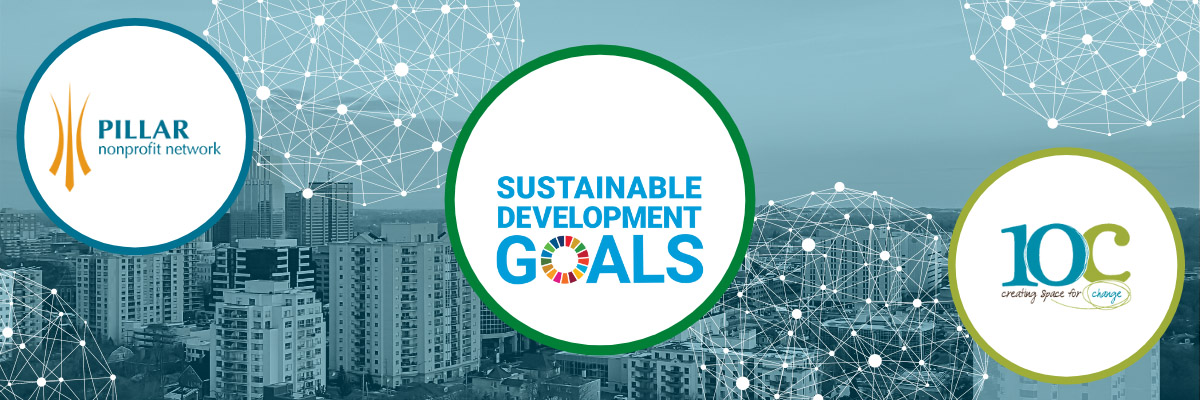
The United Nations Sustainable Development Goals (SDGs) are a framework of 17 goals intended to enable people and planet to experience shared prosperity now and for generations to come. The SDGs aim to help communities address systemic problems and make progress towards ending poverty, improving health and education, reducing inequity, spurring economic prosperity and protecting our natural environment. Through the integration of sectors, industries, levels of government and people, the framework can be used to create a more sustainable future.
As a signatory of the UN SDG’s, Canada has signaled a commitment to implementing these goals as outlined in the 2030 National Agenda. In April 2021, a grant from the Government of Canada through Employment and Social Development Canada, enabled 10C Shared Space and Pillar Nonprofit Network to launch a collaborative initiative to bring the Sustainable Development Goals in mid-sized cities - the SDG Cities project. SDG Cities will leverage global and national best practices to generate a replicable model that can be scaled to other Canadian cities and communities.
SDG Cities will develop supports, policies, and practices by working directly with multiple stakeholders in the change ecosystem, including funders, businesses, social enterprises, government and nonprofit organizations. Through education, incentives, pilot measurement strategies, and community connection, SDG Cities will increase the number of people and organizations actively using and contributing to the SDGs. When that happens, integration will emerge.
SDG Cities will promote four basic types of integration that will help municipalities meet the Sustainable Development Goals: cross-sector collaboration, the triple bottom line, alignment with multiple levels of government, and leaving no one behind.
Cross-sector Collaboration
Partnerships between public, private and nonprofit sectors have long existed and in the last few years it has become increasingly clear that one sector alone cannot solve our biggest challenges. Our cities need to have a common goal and a shared understanding of where we are and what needs to be done. The SDGs can be a shared language for our strategic goals in all different areas of city making.
Triple Bottom Line
Sustainability is usually understood primarily as environmental or ecological regeneration. A broader definition includes two other dimensions: social justice and economic prosperity. The concept of the triple bottom line introduces that environmental sustainability and social justice should be two additional lines at the bottom of a balance sheet in addition to profit and loss. The three dimensions of sustainability are interconnected and form the triple bottom line.
We are currently seeing this interconnection play out as our human health crisis has a significant impact on both our economy and our natural environment, which in turn impacts our ability to run our lives. However, this is not new information. In the book The Inner Level, Richard Wilkinson and Kate Pickett (2018) show how climate action, wealth inequality and well-being are intertwined. The Doughnut Economics model also combines the three dimensions of sustainability by setting ecological ceilings and social floors in a visually simple concept.
Alignment with Multiple Levels of Government
The implementation of national and provincial strategies are dependent on municipalities to execute their vision. We see the importance of having the Federal Government supporting cities and funding streams directed to municipalities. Our own project is an example of using federal funds to support local initiatives that can be replicated in cities throughout the country. On the other hand, cities need to align their priorities with those same national and provincial strategies, including the Towards Canada’s 2030 Agenda National Strategy. Along with the implementation of those strategies, it is necessary to measure impact. Progress at the national level is the aggregate of progress at the local level in all municipalities in Canada.
Leaving No one Behind
Last but not least, one of the main principles of the 2030 Agenda is leaving no one behind, reaching the furthest behind first - the most marginalized. For The SDG Cities project that means that we need to seek out and integrate the perspective of equity-seeking groups throughout the duration of project and into the future - from design to implementation.
One of the most important lessons of these COVID pandemic times is how we need to understand and practice integration to address the increasingly complex and urgent problems that we are facing as a global community. From the multisectoral emergency response to the interconnected impacts of the multiple crises we are facing (climate change, global pandemic, systemic racism, wealth inequality and many others), our communities are experiencing interconnected challenges, necessitating interconnected solutions. The SDG cities project will enable London, Guelph and municipalities across the county to understand the importance and applications of the four levels of integration, bringing us closer to achieving our national agenda.
Article originally posted on https://www.sdgcities.ca/
SDG Cities is a collaborative project of 10C Shared Space and Pillar Nonprofit Network
--


